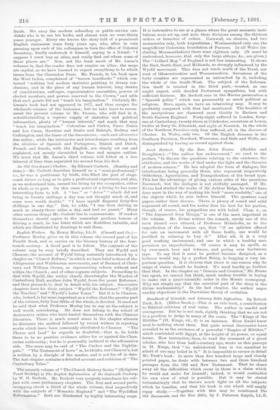The seventh volume of " The Church History Series "
(Religious Tract Society) is The English Reformation of the Sixteenth Century, by W. H. Beckett,. Mr. Beckett very properly introduces his sub- ject with some preliminary chapters. The first and second parts, occupying about a third of the whole volume, deal respectively with the subjects of "Monastic England" and "The Wycliffian Reformation." Beth are illustrated by highly interesting maps. It is instructive to see at a glance where the great monastic insti- tutions were set up, and note their divisions among the thirteen orders or branches of orders. Cornwall, we observe, had two monasteries only, both Augustinian ; Westmoreland only one, the magnificent Cistercian foundation of Furness. In all Wales (in- cluding Monmouthshire) there were eighteen only. (It must be understood, however, that only the large abbeys, &c., are given.) The "Lollard Map" of England is not less interesting. It shows the East, South-East, and Midlands, as strongly influenced by the Wyclif movement. This does not reach north of the Trent, nor west of Gloucestershire and Worcestershire. Seventeen of the forty counties are represented as untouched by it, including the whole of the South-West. The subject of the Reforma- tion itself is treated in the third part,—treated, as one might expect, with decided Protestant sympathies, but with sufficient fairness. Mr. Beckett sees in the Marian persecution a " Spanish policy " which was presumably as much political as religious. Here, again, we have an interesting map. It may be profitably compared with that last mentioned. The localities of the martyrdoms are clustered most thickly in Eastern and South-Eastern England. Forty-eight suffered in London, forty- one at Canterbury, twenty-three at Colchester, seventeen at Lewes, twelve at Bury St. Edmunds, and eight at Norwich. In the whole of the Northern Province only four suffered, all in the diocese of Chester. In Wales, only two. Of the English dioceses in the Southern Province, Hereford, Worcester, and Bath and Wells, are distinguished by having no record against them.










































 Previous page
Previous page